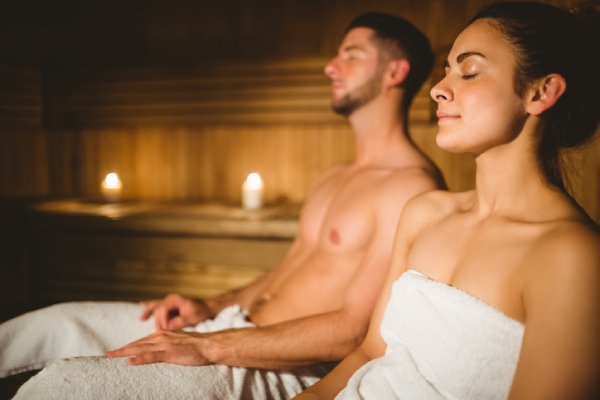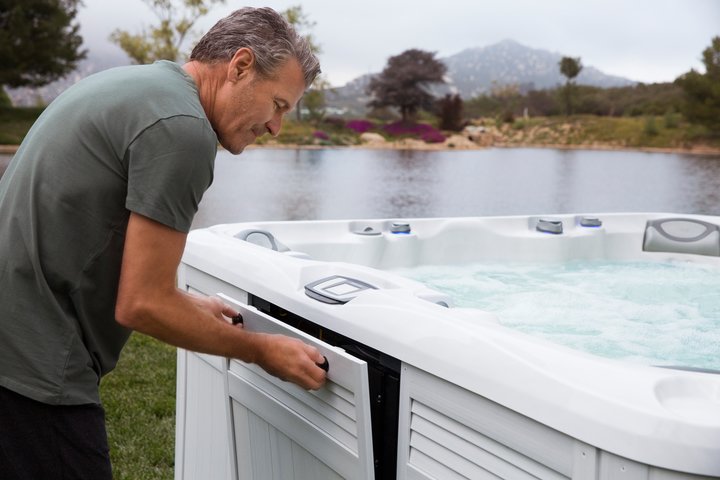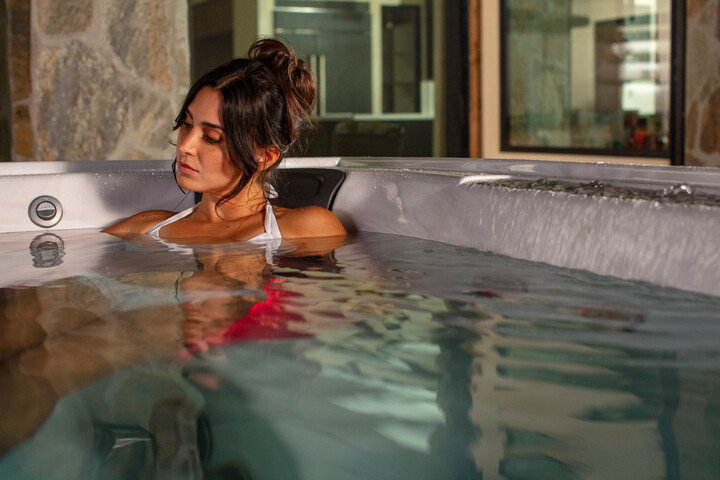A complete guide to hot tub safety by Paradise Valley Spas
Reviewing the best safety practices for hot tubs may not be as fun as relaxing in them, but it certainly beats dealing with a preventable emergency or injury. Taking the time to learn how to keep your spa safe now will help you avoid tedious and costly hot-tub headaches later.
Note that there are a variety of safety areas that you should be aware of when owning and operating a hot tub. These areas range from pre-installation to long-term maintenance, and the guidelines can differ among ages. In this post, we will cover all of these considerations to make sure you are fully prepared to enjoy your spa worry-free.
Pre-Installation Safety
Finding the Right Spot
Before installing your hot tub, it is important to identify a location for installation with minimal hazards. Consider:
- Avoiding areas with slippery surfaces that are prone to falls (you can always increase traction with anti-skid treads, rubber mats, handrails, and sand paint)
- Creating a well-lit space with outdoor/indoor lighting
- Finding an area free of falling overhead debris
- Using a lockable gate or other security measures to ensure the hot tub cannot be accessed by unsupervised children
Medical Clearance
You should also consult a physician prior to investing in a hot tub. Certain medications, as well as medical conditions, like high blood pressure and other heart conditions, are not suited to a spa environment.
Pre-Bathing Safety
Beyond installing your hot tub in a safe environment and consulting your physician, there are a number of safety procedures to address before you take a dip.
Showering
Make sure to rinse your body before entering the hot tub. Oils, chemicals, surface beauty products, and dirt can destabilize the chemical balance and water safety of the tub. These substances can also harm the motor and filter of your spa.
Plus, it’s good hygiene!
Temperature
Heat the spa to a temperature no higher than 104 degrees Fahrenheit, and take note that most spa users prefer to maintain this temperature between 100 °F and 102 °F.
If older children are using the hot tub, do not heat the tub past 100 °F. For children under the age of 10, set the temperature at no higher than 95 °F.
Spa use is not safe for infants or toddlers (children ages 5 and under).
Wear A Suit
A bathing suit, that is. Or any other water-safe material. Or, nothing at all!
However, try to avoid bathing in the clothes you wore throughout the day, as these can carry harmful bacteria.
Educate Your Fellow Spa Users
Make sure that everyone enjoying your hot tub knows best safety practices. A sign with written spa rules provides great way to remind guests to soak smartly.
Particularly, it is important that all users know where to find the emergency cut-off switch in the event that the hot tub mechanics must be shut off immediately. More on this under “Bathing Safety”.
Check for Cloudy or Foamy Water
Cloudy or foamy water is not suitable for bathing. Avoid using the tub if you notice these conditions. More on this under “Balancing Water Chemistry”.
Bathing Safety
Ahhh – so you finally get to use your hot tub. Just don’t forget to keep the following safety rules in mind while using your spa.
Monitor the Time
Your hot tub may be so relaxing that you’d like to stay in it forever. Unfortunately, spending extended periods of time in spa conditions can induce hyperthermia (overheating) and cause other health issues.
Most experts suggest a maximum bathing time between 15 and 20 minutes for adults. Children should stay in the hot tub for no longer than 10 minutes.
Avoid Diving and Facial Submersion
Hot tubs are too shallow to make any form of diving or jumping safe. Instead, you should enter your spa carefully so as not to slip or hurt yourself.
Submersion of the head and face is also dangerous. Hot water can irritate sensitive facial skin, especially if the jets are active. Jets can also increase disorientation and the risk of drowning.
Beware of Alcohol and Drug Use
We know margaritas and hot tubs sound like a great match, but the safest alcohol policy in the spa is to avoid drinking altogether. The same goes for recreational and prescription drugs.
If you do choose to indulge, moderation is key. Hot tubs can exaggerate the effects of inebriation, making you more prone to injury or harm. As always, consult a physician to learn what is safest for you.
Supervise Children
Never allow children to use the spa unattended. Even under supervision, be sure to discourage rowdy behavior that could cause harm or injury.
Avoid Handling Glass
Do not bring glass into your hot tub, or around it. Breaking glass can scatter shards throughout the tub, potentially harming users and the spa’s mechanics.
Mind the Drains
While unlikely, body parts and hair can become entrapped in the drains in extreme cases. Keep aware of drain location when using your spa, and always know the location of the emergency cut-off switch.
Post-Bathing Safety
Just a few more safety measures to remember to follow after your safe spa session is over.
Secure the Cover
Return the cover over the hot tub when the tub is not in use. Doing this will keep out unwanted debris and prevent the risk of drowning.
For Indoor Hot Tubs – Ventilate!
Ventilate your indoor hot tub to stop harmful bacteria and fumes from accumulating in the air.
Shower (Again)
Wash off after your dip to rid yourself of chemicals and any bacteria from the water.
Hot Tub Safety with Routine Maintenance
Chances are you’ll want to use your hot tub regularly, and regular use requires basic – but consistent – maintenance. Most spa owners need only spend a few minutes a day (if that) and no more than $20 per month to keep their tubs good-to-go. Below are simple instructions to make this upkeep easy.
Circulation
Circulating water in a hot tub prevents stagnation and cleans contaminants by passing it through your hot tub’s filters.
Some spas have automatic circulation schedules, which run once or twice a day without needing your attention. Other spas require manual activation of circulation, which you should turn on for 15-20 minutes, twice a day. Be sure you know which kind of model you have to determine if manual activation is required.
Cleaning
You might’ve guessed (and dreaded) this part, but yes, cleaning is essential to spa and spa user health. The good news is that hot tub cleaning is relatively quick and easy, especially if you break up cleaning duties into weekly, monthly, and quarterly schedules.
Weekly
- Fish out all debris, and remember to keep your cover on the hot tub when not in use
- Use white vinegar (not white wine vinegar) and a sponge to wipe your spa’s shell and jets
- Add a 10% bleach-to-water cleaner as an extra sanitizing measure
- Rinse your filters with warm water
- Add sanitizer and monitor pH levels (more in “Balancing Water Chemistry”)
- Shock your hot tub
Monthly
- Spray your filters with filter cleaner, and then rinse with warm water
- Consult a professional to check on your cleaning practices
Quarterly
- Drain your hot tub for a deep clean, then refill
- Soak your filters in chemical cleaner, and rinse with warm water afterward
- Inspect hardware and wiring
Balancing Water Chemistry
Balancing water chemistry refers to making sure your spa’s water has safe pH and alkalinity levels, which can fluctuate due to cleaning chemicals or other contaminants. Preserving safe water chemistry definitely falls under spa maintenance, but it is important enough to require its own section of the discussion.
pH Levels
Your spa water should have a pH level between 7.4 and 7.6. Any measure below this means the water is too acidic, which corrodes the hot tub’s hardware and irritates the skin. Any measure above this means the water is too basic, which dilutes the efficacy of cleaner.
Use pH increaser and pH decreaser to adjust these levels.
Alkalinity
Alkalinity should read between 100 parts per million and 150 parts per million. Proper alkalinity is important for preventing drastic changes in pH and can be adjusted with Alkalinity increaser.
Testing Spa Water
Test your water weekly with test strips or a liquid test kit, and determine what needs to be adjusted, if anything.
Cloudy or foamy water also indicates bad chemical balance, so test immediately in these instances and make adjustments before using your spa.
Hot Tub Safety with Paradise Valley Spas
Phew, that was a lot, but this guide is meant to be on the comprehensive side. Just remember, with great hot-tubbing comes great responsibility, as you are ultimately responsible for the safety of your spa and your spa guests. But you’ve got this. If you made it this far, you are clearly invested in safe hot tub practices.
And just by reading this article, you have already taken the first step! For more information, visit our blog or contact your local Paradise Valley Spas showroom today.




